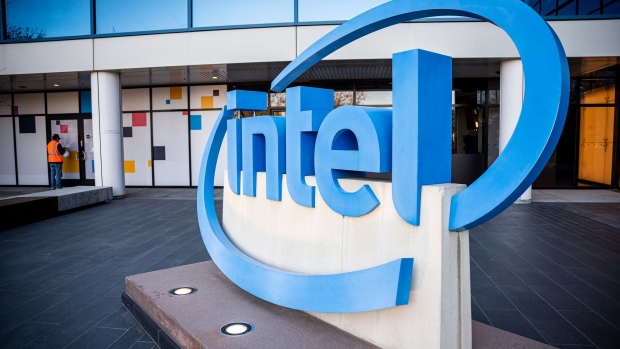Jan 25, 2024
Intel Gives Bleak Forecast in Sign Comeback Is Going Slowly
, Bloomberg News

(Bloomberg) -- Intel Corp. tumbled the most in more than three years after delivering a disappointing forecast, a reaction that Chief Executive Officer Pat Gelsinger said Friday was overblown.
The shares fell 12% to $43.65 in New York after Intel’s first-quarter projection for both sales and profit came in well short of Wall Street estimates. It was the biggest single-day decline since July 2020.
The outlook sparked fears that Gelsinger’s long-promised comeback bid has gotten off track. Though the chipmaker’s personal computer business is recovering, demand is weakening in the lucrative market for data center processors. Intel also is contending with a slowdown in programmable chips and components for self-driving vehicles, and a fledgling business that makes semiconductors for other companies hasn’t yet taken off.
Gelsinger said the market reaction to Intel’s forecast was “overstated” and pointed to better-than-expected results in the fourth quarter. “Q4 beat on top and bottom line, finishing a year that was comfortably ahead,” he said in an interview on Bloomberg Television. “It’s showing the transformation journey that we’re on.”
Intel’s stock was already down 1.4% so far this month through Thursday’s close, trailing a 7.1% advance by the closely watched Philadelphia Stock Exchange Semiconductor Index.
Sales in the first quarter will be $12.2 billion to $13.2 billion, the Santa Clara, California-based company said Thursday. That compared with an average analyst estimate of $14.25 billion, according to data compiled by Bloomberg. Profit will be 13 cents a share, minus certain items, versus a projection of 34 cents.
Wells Fargo analyst Aaron Rakers called the post-earnings selloff justifiable, and said questions remain about when Intel “will find its footing” as competitors benefit from spending on AI computing.
During a conference call with analysts, Gelsinger acknowledged that the first quarter wasn’t going as well as hoped, but that he expected the rest of 2024 to improve quarter by quarter. Intel’s efforts to return to the cutting edge of manufacturing are still on track, he said. That’s crucial to improving its products and staying competitive. He also asserted that the chipmaker is no longer losing sales to competitors in PCs and data centers.
“We know we have much work in front of us as we work to regain and build on our leadership position in every category in which we participate,” Gelsinger said.
One of the most ambitious pieces of Gelsinger’s plan is a push into manufacturing chips for others — a field known as the foundry industry. Intel committed to spending heavily on a network of plants around the world to further that effort. But the company hasn’t yet gone public with the names of large customers participating in the project.
Without getting specific, Intel said Thursday that it had $10 billion worth of “lifetime deal value” orders to make and package chips for other companies — evidence of progress in this new area.
Under questioning, Gelsinger said that the deals it has booked so far aren’t enough.
“Obviously, we need to, as your question suggests, get to a much bigger number, and that’s exactly what we’re going to do,” he said.
Nvidia Corp. and Advanced Micro Devices Inc. have remained the stock-market darlings of the chip sector, largely because investors expect them to benefit the most from a surge in spending on artificial intelligence-related infrastructure.
Gelsinger said that Intel will make headway in the market for so-called AI accelerators — Nvidia-style chips that help speed the development of artificial intelligence models. The growth of the AI industry will also increase demand for Intel’s regular data center processors, he said.
“Intel has the ability to participate in 100% of the AI market,” Gelsinger said in the Bloomberg TV interview.
But Intel’s efforts to upgrade its facilities will weigh on profitability this year — with the hoped-for payoff not coming until later.
Intel’s gross margin — the portion of sales remaining after deducting the cost of production — will be 44.5% in the first quarter. That compares with an estimate of 45.5%. Prior to the onset of its current problems around 2019, Intel typically reported profitability of well over 60%.
In the fourth quarter, earnings came in at 54 cents a share on sales of $15.4 billion. Analysts had estimated profit of 44 cents and revenue of $15.2 billion.
Data center sales were $4 billion, falling short of the average projection of $4.08 billion. Client computing, Intel’s PC chip business, had sales of $8.84 billion. That compared with an estimate of about $8.42 billion.
Intel has said that the market for PCs is emerging from a glut of inventory and its largest customers are returning to ordering parts. Total PC shipments should rise to about 300 million units a year, Gelsinger has said, helped by demand for new machines that are better able to handle artificial intelligence software and services. The total for 2023 was about 270 million, and growth will be a few percentage points this year, he said.
In servers, where Intel once had a market share of more than 99%, the company is facing more competition and a shift in spending patterns. Longtime rival AMD has fielded increasingly powerful chips that are winning over customers. In another troubling sign for Intel, some of the world’s biggest spenders on the technology – including Amazon.com Inc.’s AWS and Microsoft Corp. – are designing their own processors.
Intel’s outlook also has been clouded by a division that it partially spun off. Earlier this month, Mobileye Global Inc., a maker of autonomous driving technology, gave a full-year forecast that was well below analysts’ predictions. Intel is still the majority owner of the Israeli company.
--With assistance from Subrat Patnaik.
(Updates trading starting in second paragraph. A previous version of this story corrected the wording of an Intel comment.)
©2024 Bloomberg L.P.





